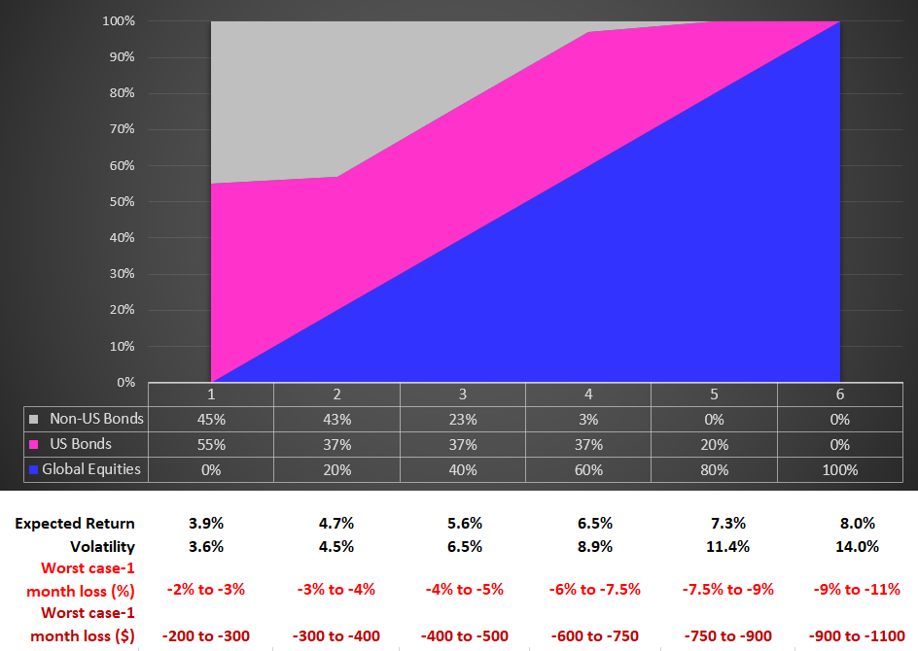Ingredients and Steps for a Global Investment Portfolio that You can Easily Implement and Rebalance
Let's look at the building blocks one by one

Assuming you want to bake a cake, there are four decisions for you to make:
First, how do you prefer the cake to taste and feel? Rich and creamy? Light and layered? Lemon, cherry, or chocolate-flavoured?
Second, what are the ingredients?
Third, what is the measurement of each ingredient?
Fourth, how do you mix them to make the best and most satisfying cake FOR YOU?
4-Step Process of Forming a Portfolio
Creating an investment portfolio turns out to be similar.
First, you must understand your investment objective and the risk level you prefer to take and can withstand.
Second, you must decide what investment universe or positions belong to your portfolio.
Third, you need to determine what are the weights of each position.
Fourth, to determine the above weights, you need a mechanism to find the best mix of the positions to create the most optimal portfolio in alignment with your objective and risk preference.
Let’s Start with an Investment Universe with 3 Positions
Your first reaction may be: should we not put all eggs in one basket; would 3 positions be too few?
You are right to think this way!
However, the 3 positions here are not just single stocks or bonds. Each of the positions is intrinsically well-diversified.
We will use 3 Exchange-Traded Funds (ETFs), a basket of securities trading on an exchange just like a stock. The underlying securities track a market index such as the S&P 500 or a sector index such as the Invesco QQQ that tracks the Nasdaq-100 companies. Each index holds hundreds and thousands of securities.
You can read more about the differences between stocks, ETFs, and mutual funds.
The following is for educational purposes only and does not constitute investment advice. Please conduct your research independently or consult your financial advisor.
Step 1: How Much Risks can you Tolerate and Withstand
There are three components of a risk profile assessment: (1) how many losses can an individual tolerate for a specified period say in a day or a month; (2) what is the investment objective? Income, capital appreciation, or preservation; (3) what is the capacity of an individual to take on risk? Here we consider her income, cash flow need, yearly income, existing resources, and the time horizon for the investment.
Various investment companies offer online risk assessment calculators like the one by Fidelity or this one. Once you have answered their questions, you will be presented with a description of your risk profile or the allocation between stocks (the more volatile asset class) and bonds.
Step 2: Identify Your Investment Universe and Positions
The investment universe consists of positions suitable to your circumstances and risk objectives. For example, if you want a steady income and lower fluctuations in your portfolio value, you would not put all your money into small technology stocks, which usually pay no dividends. Their profits are much further in the future. The companies can fail, too. Instead, you would like more established dividend-paying companies that pay year-in-year out from their underlying business profits.
In the following example, I assume you want to be as broadly diversified as possible and seek some balance between more volatile stocks and steadier income-paying bonds without picking any stocks. Mind you, some stocks also pay dividends regularly.
The 3 ETFs used to build our portfolio are:
ACWI - tracks an index containing large and mid-capitalization developed and emerging market equities.
AGG - tracks an index consisting of the total U.S. investment-grade bond market.
IAGG - tracks a basket of global non-U.S. dollar-denominated investment-grade bonds. Note developing markets bonds are excluded.
(Note: while the above are all ETFs offered by BlackRock, you can use similar ETFs offered by Vanguard, Schwab, etc. - many vendors offer similar ETFs that track the same underlying indices.)
The significance of these 3 ETFs is they together represent the global investable investment universes in traditional equities and high-grade bonds based on their market cap weights.
(Market cap measures the outstanding value of that stock or bond.)
Combining Steps 3 and 4: Finding The Right Allocation for You
Now comes the crucial step(s): determine the allocation (weights in %) to invest.
(1) After using a risk assessment calculator (as shown above) or consulting your advisor or a Robo-Advisor, you may get a recommendation for the asset class allocation: stocks vs. bonds allocation. For example, a middle-aged professional having a long investment horizon and high earnings power may start with a 60% stock and 40% bond allocation. Then your advisor will further recommend the stock and bond selections within each asset class regionally diversified or factors-enhanced. Other asset classes include gold, real estate, and other private investments.
(2) The more quantitative-oriented individuals and professionals may use a more robust system to generate asset allocation using portfolio optimization methods based on expectations of future returns and how the positions have performed relative to each other in the past (correlations). The key concept is if we combine different positions in a portfolio, the risk (measured by volatility or the dispersions of the returns) of that portfolio will be lower than the weighted average volatility of the components within the portfolio.
A caveat I want to mention is that the correlation (ranging from -1 to 1) is not always stable amongst the asset classes. Chart 1 below shows the correlation between global stocks in the U.S., EAFE, Emerging Markets, U.S. bonds, and ex-U.S. global bonds.
Notice that the weekly correlation (relative movement) between U.S. stocks and U.S. bonds is almost 0 from April 2010 to April 2013. When stocks are doing poorly, government bonds act as a safety hedge.
However, in 2022, the correlation between U.S. stocks and U.S. bonds was much higher at 0.38 and even higher between U.S. stocks and Global non-U.S. bonds at 0.58. The S&P 500 fell 18% while the U.S. aggregate bonds dropped 13% last year.
Portfolio optimization aims to maximize the (expected) return the (rational) investor will get per unit of risk undertaken.
In Chart 2, using the portfolio optimization technique, I have provided a chart and table to show the allocation to our 3 ETFs representing Global Equities, U.S. Investment Grade Bonds, and Non-U.S. Investment Grade Bonds.
As the allocation to stocks increases, the expected future return and the volatility also rise.

How might one decide on the right equity versus bonds mix?
Remember the risk profiling exercise in Step 1? You already know how much risk you can tolerate and withstand.
You can correlate your risk profile with the following portfolio:
Very Risk Averse: Portfolio 1
Moderately Risk Averse: Portfolio 2
Moderate: Portfolio 3
Moderate Growth: Portfolio 4
Growth: Portfolio 5
High Growth: Portfolio 6
To put some more numbers into perspective, see Chart 3 below. I have quantified worst-case one-month losses for you (your average losses in the worst 5% of your days) under each asset allocation (Portfolio 1 to 6).
Would this help you to choose better?
For example, I expect 5 to 6% returns per annum with a worst-case 1-month loss of no more than 5%. Then I will choose a 40% equities, 60% bonds portfolio, or Portfolio 3.

One More Note about Volatility and Riskiness
Warren Buffett has made this point before in his 2017 shareholder letter - stocks are not necessarily riskier than bonds all the time. Stocks are generally more volatile than bonds.
I want to quickly acknowledge that in any upcoming day, week or even year, stocks will be riskier– far riskier– than short-term U.S. bonds. As an investor’s investment horizon lengthens, however, a diversified portfolio of U.S. equities becomes progressively less risky than bonds, assuming that the stocks are purchased at a sensible multiple of earnings relative to then-prevailing interest rates.
It is a terrible mistake for investors with long-term horizons– among them, pension funds, college endowments and savings-minded individuals– to measure their investment “risk” by their portfolio’s ratio of bonds to stocks. Often, high-grade bonds in an investment portfolio increase its risk.
~ Warren Buffett
Closing Thoughts
In this article, I have shared the four steps of building a globally diversified portfolio using 3 ETFs representing the global markets in stocks and bonds.
Understand your investment objective and the level of risks you prefer to take and can withstand.
Decide what investment universe or positions are suitable in that portfolio.
Determine the weights (%) of each position.
(Related to 3), find the best mix of the positions to create the most “optimal” portfolio in alignment with your objective and risk preference.
You may be surprised by how simple the portfolio is. Famous investment banker and author Michael Lewis once said his portfolio consists of low-cost index funds, Berkshire Hathaway (trusting Warren Buffett will decide which stocks to buy for him), and U.S. Treasury Bonds.
An investment portfolio need not be complex or filled with bells and whistles. The simpler the portfolio, the more you understand how it works.
One of the worst mistakes in investing is overconfidence in what you own in the portfolio and what you THINK you know. When the fundamentals change, you hang on to the position because you do not question what you know. A related mistake is the sunk cost fallacy: the tendency to persist with a decision or course of action that has already incurred costs, even when the decision is no longer rational or beneficial.
Should you find yourself in a chronically leaking boat, energy devoted to changing vessels is likely to be more productive than energy devoted to patching leaks.
~ Warren Buffett
A better way of investing is to start with appropriate asset allocation (top-down), be diversified, and focused on the long-term. The valuation (cheap or expensive) of the stocks and bonds you first put in the portfolio matter.
I hope you find this helpful. Please feel free to let me know if you have questions!
This article is for informational purposes only. It should not be considered financial or legal advice. Not all information will be accurate. Consult a financial professional before making any major financial decisions.
The author is a co-founder, partner, and portfolio manager at Lumen and has been investing in the global markets for over 25 years. She started her buy-side investment career in the mid-1990s as a fixed-income analyst in an international mutual fund company right after MBA graduation and became a Chartered Financial Analyst.




